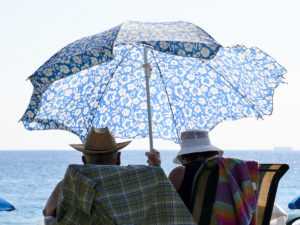 Even in short exposure periods, severe temperatures such as these can be extremely hazardous and at times fatal. According to the National Weather Service, approximately 1,220 people die each year from extreme heat. Despite the threat heat poses to the body, heat-related deaths and illnesses are preventable.
Even in short exposure periods, severe temperatures such as these can be extremely hazardous and at times fatal. According to the National Weather Service, approximately 1,220 people die each year from extreme heat. Despite the threat heat poses to the body, heat-related deaths and illnesses are preventable.
To stay healthy and safe during the heat advisory, the department would like to offer the following tips from the National Weather Service, Centers for Disease Control and Prevention (CDC), and the American Red Cross.
Heat Safety Tips During Extreme Heat
-
Stay hydrated by drinking plenty of fluids. Replace salt and minerals with snacks or a sports drink. Avoid alcoholic drinks.
-
KEEP COOL – Spend as much time as you can in cooler surroundings. Use air conditioners to cool the air. Do not rely on a fan as your primary cooling device during a heat advisory.
-
Check on family, friends and neighbors who do not have air conditioning, who spend much of their time alone or who are more likely to be affected by the heat
-
Factors that may impact a person’s ability to cool off during a heat wave include age, weight, dehydration, heart disease, poor circulation, sunburn, and prescription drug and alcohol use.
-
In particular, those over age 65 or under age two, people with chronic medical conditions, and pregnant women are those at the highest risk during an extreme heat event.
-
If someone doesn’t have air conditioning, they should seek relief from the heat during the warmest part of the day in places like libraries, theaters, malls, etc. Call your local Council on Aging or Police Dept for information on cooling sites in your community.
- Going to the beach? Visit the beach during the morning or late afternoon/evenings, when it is coolest.
-
Protect yourself from the sun by wearing a wide-brimmed hat, sunglasses, and by putting on sunscreen of SPF 15 or higher 30 minutes prior to going out.
-
Wear loose-fitting, lightweight, light-colored clothing. Avoid dark colors because they absorb the sun’s rays.
-
Slow down, stay indoors, and avoid strenuous exercise during the hottest part of the day, which is typically around 3 p.m.
-
Postpone or withdraw from outdoor games and activities if the temperature is too hot.
-
Use your stove less and try to cook your meals in the cooler part of the day.
-
Take frequent breaks if working outdoors. The CDC recommends workers performing heavy-duty work in 96-degree temperatures should work for 45 minutes and rest for 15.
-
Hot cars can be deadly. It is never safe to leave a child, disabled person, or pet in your vehicle. Cars can quickly reach 100-degree temperatures, leaving unattended passengers vulnerable to sudden heat-related illnesses.
-
Check on animals frequently to ensure that they are not suffering from the heat. Make sure they have plenty of cool water. Do not leave your animals outdoors unattended for more than 15 minutes.
-
Parents should limit playtime at peak sun exposure time and familiarize themselves with the signs of heat illnesses. Any playground equipment or outdoor toy that is hot to the touch is too hot for a child to safely use.
Symptoms of Heat Stroke
-
A fever above 103 degrees
-
Hot, red, dry, or damp skin
-
Rapid, strong pulse
-
Headache
-
Dizziness
-
Fainting
-
Confusion
-
Nausea
In case of heat stroke, call 911 immediately. Move the person into a cool place. Attempt to cool the body down using wet cloths, fanning, misting, or a cool bath. Do not give the person anything to drink.
Symptoms of Heat Exhaustion:
-
Heavy sweating
-
Cold, pale, and clammy skin
-
Fast, weak pulse
-
Nausea or vomiting
-
Muscle cramps
-
Tiredness or weakness
-
Fainting
-
Dizziness
In case of heat exhaustion, move to a cool place, tighten any loose clothing, attempt to cool the body, and sip water slowly. Seek medical help immediately if vomiting occurs, symptoms last longer than an hour or get worse, or if confusion develops.
For more information about heat stroke and heat exhaustion from the CDC, click here.
